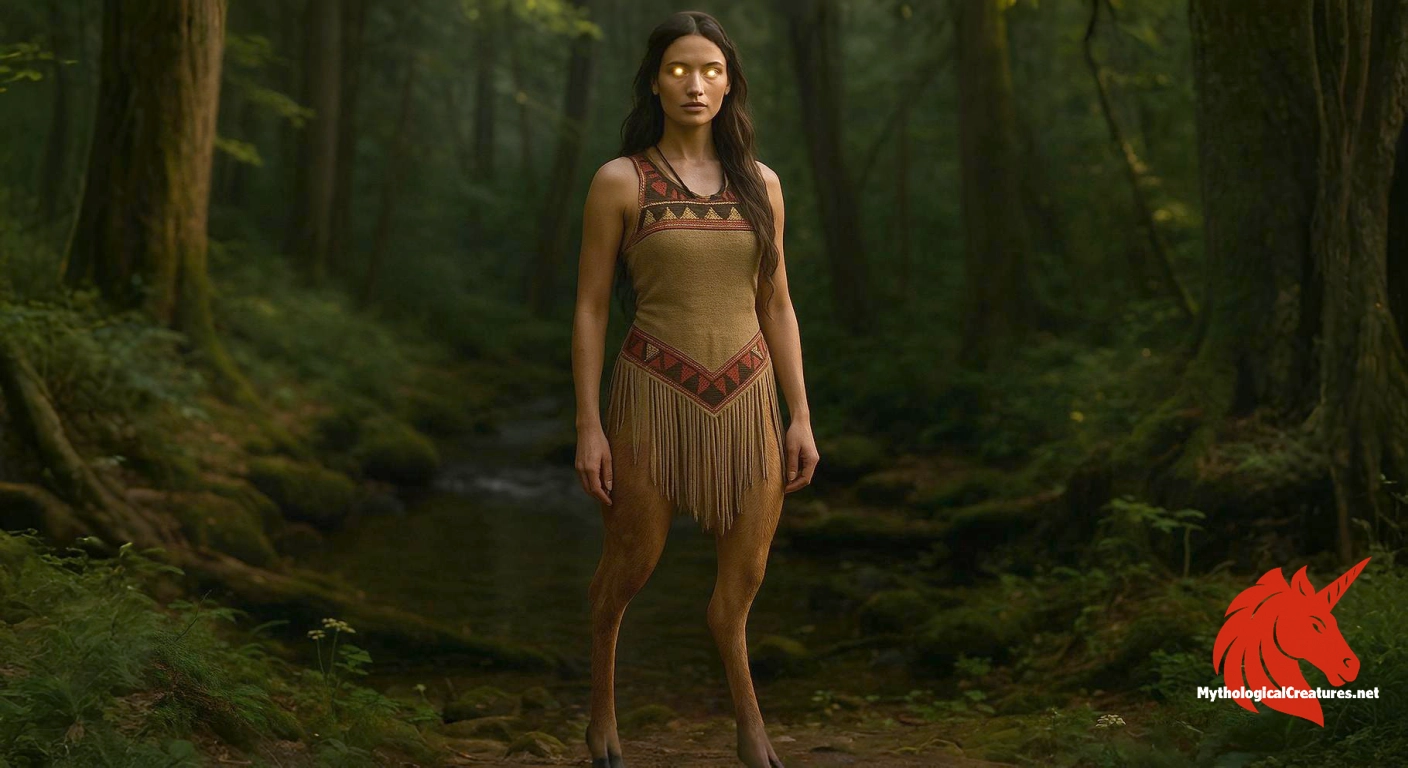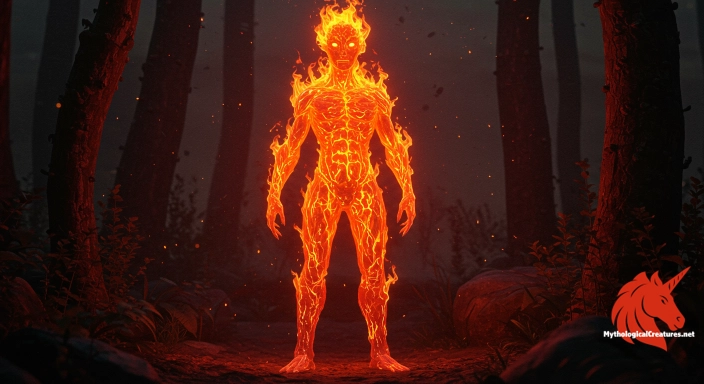Deer Woman: Deer Woman is a vengeful spirit from Native American mythology known for her dual appearance as both a beautiful young woman with deer feet and as a deer.

Deer Woman
Deer Woman - Embodies the interplay of nature and justice, serving as a cautionary figure against harm to women and children.
Origins & First Encounters
Deer Woman stands as a compelling figure in Native American mythology, embodying both the beauty of the wild and the severity of retribution. Her origins trace back to ancient oral traditions, where narratives of the natural world were interwoven with moral instruction. Early attestations reveal her role as a protector of women and children, while also serving as a warning to those who commit grievous wrongs. Stories passed down through generations highlight her dual nature—both nurturing and fearsome—in the vast tapestry of indigenous lore. She is frequently depicted as a spirit whose beauty is matched only by her capacity for vengeance. In many traditions, her appearance signals the presence of nature’s unpredictable and transformative forces. Her myth has been a vehicle for conveying societal values, emphasising the importance of respect towards both the environment and each other. The enduring legacy of her story reflects a deep-rooted cultural awareness of the balance between compassion and justice. Her enigmatic persona continues to evoke both admiration and caution among those who encounter her tale. Ultimately, Deer Woman remains a symbol of the intertwined forces of creation and retribution that define human interactions with nature.
Source Texts & Tale Variants
Accounts of Deer Woman are preserved primarily through a rich tapestry of oral traditions rather than through a single ancient text. Elders and storytellers amongst various tribes have passed down her legend, each version imbibing the spirit of its own community. Many of these narratives focus on her role as an agent of karmic retribution, particularly for men who have inflicted harm upon the vulnerable. Diverse retellings place her transition between forms at the centre of her identity, with one version describing her as a bewitching maiden and another as the very embodiment of a deer. Her story is woven through communal gatherings, where recitations and ceremonial retellings ensure that her message remains vibrant. Over time, subtle variations in the narrative have introduced nuances that reflect local customs, moral codes, and environmental concerns. In some variants, her presence is linked to seasonal cycles and the rhythms of the natural world, further deepening her mystique. The evolution of her legend through folklore has allowed her to adapt, absorbing new cultural values while retaining core elements of warning and retribution. These layered accounts present a multifaceted character whose story is as much about personal morality as it is about the natural order. Ultimately, the collective storytelling of her myth embodies the dynamic interplay between tradition, adaptability, and local interpretation.
Form & Powers
Deer Woman is envisioned with a striking blend of human and animal features that evoke both allure and latent danger. Her upper body exhibits the graceful form of a young woman, complete with captivating eyes that reflect the wisdom of ages. Below the waist, her legs transition into the delicate, sinewy structure reminiscent of a deer, complete with the soft and agile deer feet that lend her an otherworldly quality. This melding of forms produces a silhouette that is at once both elegant and enigmatic. She is often described as possessing an ethereal glow, as if lit from within by the light of the moon. Her flowing hair, wild and unrestrained, seems to echo the untamed spirit of the forest. At times, subtle details such as hints of antler-like adornments or a delicate pattern of markings on her skin further connect her to the natural world. The variation in her physical portrayal—alternating between a fully humanoid appearance and that of a deer—underscores her dualistic nature. Each detail, from the luminous texture of her skin to the graceful trajectory of her movements, serves as a reminder of the delicate balance between beauty and peril. Overall, her physical description is a powerful visual metaphor for the union of humanity and the wild, woven into the fabric of myth.
Regional Faces
Across different Native American tribes, the depiction of Deer Woman reflects a complex interplay between local environment and cultural values. In the woodlands of the East, she is often revered as a spectral guardian whose presence exemplifies the sanctity of nature. Among certain Plains tribes, her myth is interlaced with ceremonial practices, casting her as both a nurturer and a punisher depending on the social context. In areas where the landscape is dominated by dense forests and winding rivers, her form is sometimes depicted with a softer, more maternal aspect, highlighting the nurturing side of nature. Conversely, in regions that have experienced histories of injustice or exploitation, her legend adopts a distinctly vengeful tone as a form of moral reckoning. These regional interpretations underscore the adaptability of her myth, with each community shaping her characteristics to mirror their unique relationship with the land. Local narratives may emphasise her protective attributes, serving as a living reminder of nature’s capacity to both heal and judge. The diverse geographical backdrops serve to colour her legend, imbuing her figure with local symbols and natural motifs. As a result, Deer Woman transcends her singular identity, becoming a reflection of the varied cultural landscapes and values of different indigenous communities. Her regional variations not only preserve ancient wisdom but also adapt it to the realities of different environments and historical experiences.
Cultural Parallels
The narrative of Deer Woman naturally invites comparisons with mythic figures from a wide range of cultural traditions. Much like the sirens of classical mythology, her mystique lies in the dangerous allure that draws mortals toward their own undoing. Her ability to morph between human and animal states mirrors similar shapeshifting qualities observed in other folklore beings across the world. The motif of a seductive yet deadly spirit can also be seen in European faerie tales, where appearances mask peril beneath ethereal beauty. In many indigenous cultures, figures that embody the wild and untamed aspects of nature serve as moral arbiters, a role that Deer Woman fulfils with unique intensity. This cross-cultural resonance underlines the universal human fascination with the transformative powers of nature. While many legends portray such entities solely as temptresses, Deer Woman’s narrative incorporates a profound moral dimension, invoking retribution against cruelty. Comparisons can also be drawn to other natural guardians whose powers serve as both a blessing and a curse to humanity. These shared themes highlight the enduring appeal of figures who occupy the space between benign beauty and fierce justice. Ultimately, such cultural parallels underscore how different societies have used similar archetypes to negotiate the delicate boundaries between civilization and the wilderness.
Legacy & Modern Evolution
Over the centuries, Deer Woman has experienced a significant evolution in both her portrayal and symbolism. Her original presence, embedded in ancient oral traditions, has been continually reinterpreted to address contemporary concerns and values. Modern retellings tend to highlight her as a symbol of environmental stewardship as well as a moral guardian safeguarding the innocent. In literature, film, and art, her character is often recast as a complex figure whose beauty masks a dangerous retribution against those who exploit nature and its denizens. Her myth has been revitalised, embracing themes of feminism, justice, and the critical balance between humanity and the earth. Contemporary narratives frequently depict her as a haunting reminder of the dire consequences of social and ecological transgression. As modern communities grapple with environmental degradation and shifting societal roles, her enduring legacy serves as a powerful allegory. The reimagining of her tale in various media illustrates how legends adapt to the prevailing cultural climate while maintaining their ancient essence. Illustrations of her mysterious visage continue to inspire dialogue about the interactions between humans and the non-human natural world. In this way, Deer Woman remains both a timeless moral figure and a potent emblem of the unpredictable forces that shape our shared existence.
Interesting Fact
An intriguing aspect of Deer Woman is her embodiment of duality—not only does she traverse the boundary between human and animal forms, but she also represents the fine line between beauty and terror, serving as a complex moral force within Native American mythology.
Quick Creature Info
Origin:
Features:
Associations:
Our Mythic Legendary Rating:

Also Sometimes Known As:
Habitat:
Supernatural Powers:
Physical Attributes:
Abilities:
Behavior:
Lore:
Related Creatures, Tales or Lore
- SSiren
- HHuldra
- LLa Llorona
References
Discover Another Mythical Legend You May Not Have Heard Of?
Uncover the mysteries of ancient folklore and expand your knowledge of legendary beings from cultures around the world.
Dare to Meet the Od iyesi....
Mythical Disclaimer: The images and data on this site are derived from various historical and literary sources, but we have found that many myths often have multiple versions and interpretations across references, sometimes contradictory. As a result, these creature depictions are artistic interpretations—imaginative blends of folklore, legend, and a dash of AI guesswork. Because creature descriptions vary widely, our illustrations and accompanying information represent our best effort to honor mythology while bridging creative gaps. Enjoy these interpretations—just remember, we've done our best to respect the stories and validate available data, but in the realm of mythology, details often shift, imagination leads the way, and nothing is ever set in stone!
Curated by the Mythological Creatures Team (rev. May 2025)
